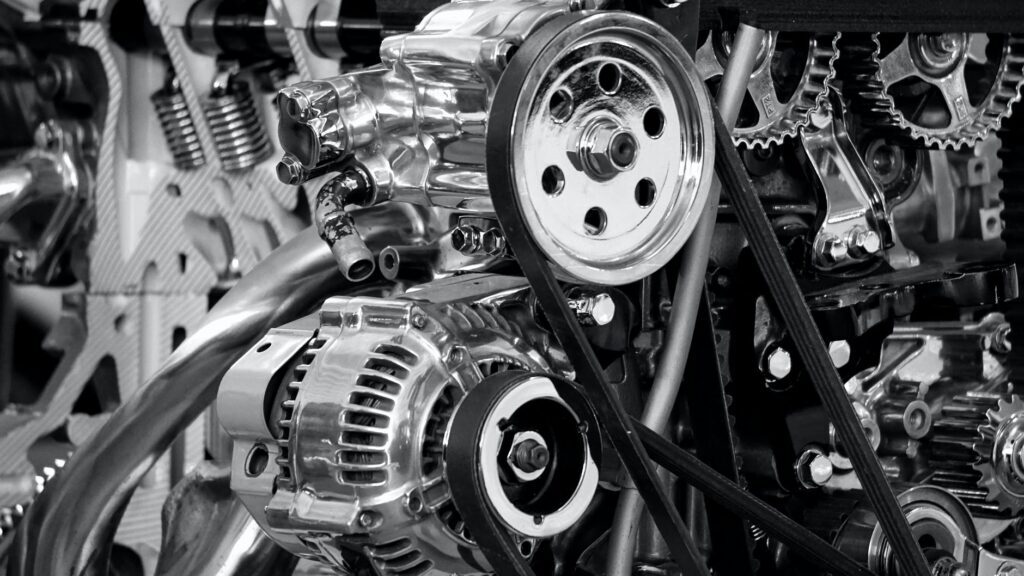How ATV Engines Work: What Powers the Vehicle?


The joy of riding an ATV — the speed, freedom, and exhilaration — comes from the engine. Without an engine, an ATV has no power, which means it is not much fun. To help riders and ATV enthusiasts understand how this critical equipment works, we’ve put together a guide.
ATVs use one of two types of engines: two-stroke ATV engines and four-stroke ATV engines. Most modern ATVs use four-stroke engines, but even those that use two-stroke engines are an upgrade from early ATVs. The ‘stroke’ refers to the number of rotations the engine piston must make (outlined below).
Two-stroke engines can be more efficient overall because fuel is always burning, and the engine is lighter without an oil reservoir. That said, a two-stroke has lower fuel efficiency as a result, which can cost more. It can be more challenging for those who love speed to get up to fast driving speeds.
A two-stroke engine is louder, which may be an advantage or disadvantage depending on your riding style and goals! Finally, two-strokes have fewer moving parts, so repairs can be less expensive and easier to DIY.
A four-stroke engine has an oil reservoir and requires regular oil changes. The engine can generate more power with lower RPMs, which means the engine is more reliable overall and more fuel-efficient. That said, more moving parts mean more things to repair.
Generally, remember that a two-stroke is light and easy to fix but requires some math and mixing. A four-stroke is reliable and fuel-efficient, but requires more mechanical expertise, or a budget for shop repairs and maintenance.
Depending on what you are looking at buying, the decision may be made for you. Many modern machines are only available with four-stroke engines, largely thanks to their more eco-friendly profile. A two-stroke ATV is likely to be older or a second-hand find from eras where two-strokes were more popular.
Here’s how a four-stroke engine works. The starter engages the engine and the piston moves down into the cylinder. At the same time, the intake valve opens, pulling air and fuel into the cylinder.
When the piston reaches the bottom, the intake valve closes and the piston starts moving back up to compress the fuel/air mixture. That is when the spark happens, creating a small explosion inside the cylinder. That burns off the fuel and air mixture and forces the piston back down again. It moves back up one more time, as the exhaust valve opens to let burnt gasses out through the exhaust.
In a two-stroke engine, the power cycle is completed in two rotations. The piston starts at the bottom center of the cylinder. The rotating crankshaft pushes the air and fuel mixture into the cylinder, and that mix is compressed as the piston moves upward. This is the first half of the stroke.
When the piston gets to the top center position, the spark plug ignites the fuel and air mix, which pushes the piston back down. Exhaust gases are expelled as more fuel and air is brought in.
Fuel mix travels through the crankcase throughout this process, which necessitates oil to lubricate the case. Two-stroke engines often require pre-mixed fuel and oil. If you want to avoid this, look for an engine with an oil injection feature, which does this for you.
When the engine is powered through these piston strokes, whether two or four, it turns the ATV’s wheels.
Here’s a bonus feature of some ATV engines. Today’s modern ATVs often link the engine and a continuously variable automatic transmission (CVT). With a CVT, a rider does not have to worry about shifting gears as the ATV automatically determines the gear ratio. This allows for the engine to operate at optimum power and efficiency, even in varying conditions.
The CVT system looks at speed, RPM, and load to decide what gear ratio is best. It operates with a drive pulley connected to the engine, a drive pulley connected to the transaxle, and a belt. Each pulley has weighted sheathes that work on centrifugal force, changing the diameter of the pulley. The belt moves back and forth to determine the gear ratio.
If your ATV has a CVT system, it’s vital to ensure the transaxle is lubricated. The CVT itself does not require lubrication, but the CVT will suffer if the transaxle runs dry. These are relatively expensive, sophisticated systems, so it’s well worth the transmission maintenance.
Disclaimer: While we endeavor to keep the information on our blog up to date and correct, Maxtrade (Coolster) makes no representations or warranties of any kind, express or implied about the completeness, accuracy, reliability, suitability, or availability with respect to the website or the information, products, services, or related graphics contained on the website for any purpose. Any reliance you place on such material is therefore strictly at your own risk.
Register